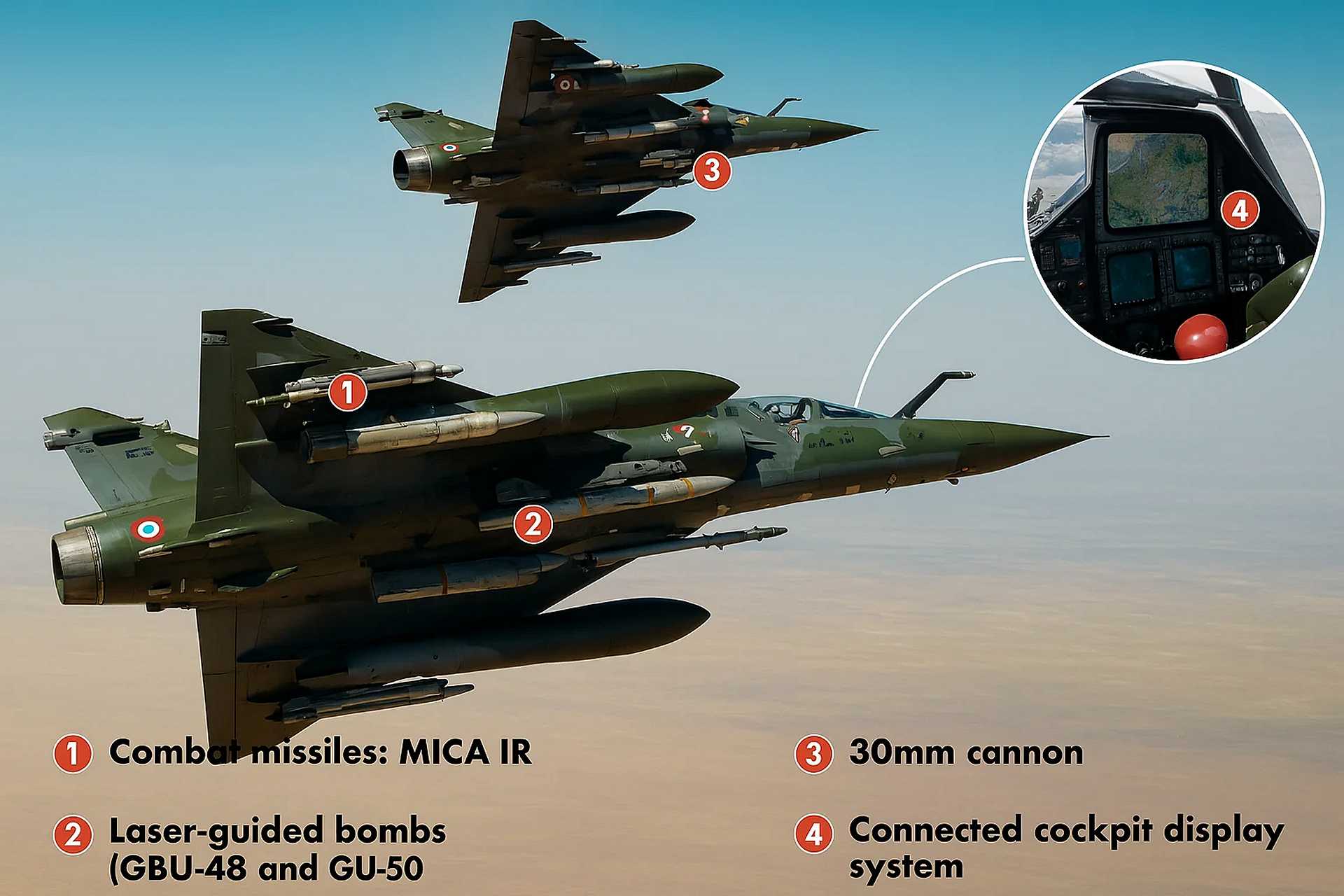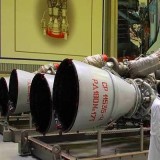Exclusive: New Mirage 2000D RMV Fighter Jet for French Air Force Enhances Combat Capabilities for Multi-Theater Operations

{loadposition bannertop}
{loadposition sidebarpub}
On April 9, 2025, the French Air and Space Force significantly enhanced its tactical airpower with the operational introduction of the Mirage 2000D RMV (Rénovation à Mi-Vie). This comprehensive mid-life upgrade breathes new life into 50 Mirage 2000 D aircraft, originally introduced in the 1990s, by equipping them with cutting-edge technology, modern weapon systems, and advanced mission capabilities. More than a simple modernization effort, the RMV program transforms the Mirage 2000 D into a highly capable, multi-role combat aircraft that remains fully relevant in today’s dynamic and complex battlefield environment.Follow Army Recognition on Google News at this link
The Mirage 2000D RMV, the modernized variant of France’s tactical strike aircraft, integrates a 30mm internal cannon for close air support, MICA IR short-range missiles for enhanced self-defense, and precision-guided GBU-48 and GBU-50 bombs for all-weather strike capability, all supported by a fully digital cockpit and upgraded mission systems that provide improved situational awareness and full interoperability in modern combat operations. (Picture source: French MoD)
At the heart of the RMV transformation lies a major enhancement in firepower and operational effectiveness. One of the most notable upgrades is the addition of the 30mm DEFA internal cannon. Previously absent from the original Mirage 2000 D configuration, this cannon provides a vital close air support capability, enabling pilots to engage enemy forces with high precision in scenarios that require immediate and flexible firepower. This capability is particularly valuable in irregular warfare and counter-insurgency operations where rapid response and surgical strike capability are crucial.
In the air-to-air combat domain, the RMV has replaced the aging Magic 2 missile system with the MICA IR, marking a substantial leap in missile technology. The MICA IR is not merely a short-range missile; it is a highly versatile interceptor equipped with a dual-band imaging infrared seeker that allows for advanced target recognition and resistance to countermeasures such as flares. Unlike the Magic 2, which relied on line-of-sight infrared homing, the MICA IR features “lock-on after launch” capability, allowing the missile to acquire targets after being fired and thereby increasing tactical options for the pilot. It offers an extended engagement range of up to 60 kilometers, with a top speed of approximately Mach 4 (around 4,900 km/h), and advanced thrust vector control, enabling it to outmaneuver even the most agile enemy aircraft. These characteristics drastically improve the aircraft’s survivability and self-defense in contested airspace, making the Mirage 2000 D RMV significantly more lethal in aerial engagements.
The RMV upgrade also focuses heavily on precision strike capabilities, particularly through the integration of modern guided munitions. The Mirage 2000 D RMV can now deploy the GBU-48 and GBU-50 laser-guided bombs, part of the Enhanced Paveway II family. The GBU-48 is based on the 454 kg Mk 83 bomb, while the GBU-50 is derived from the 907 kg Mk 84. Both munitions incorporate dual-mode guidance systems combining GPS/INS navigation and laser terminal guidance. This allows them to be employed effectively in both clear and adverse weather conditions, and against both stationary and moving targets. Dual-mode guidance significantly increases flexibility and effectiveness, enabling last-minute target updates and reducing dependency on GPS signals in electronically contested environments. With these precision munitions, the Mirage 2000 D RMV delivers powerful, accurate, and low-collateral damage strikes, perfectly aligned with the operational demands of modern warfare.
Beyond the new weapons suite, the RMV standard introduces a substantial overhaul of the aircraft’s avionics and digital systems. The cockpit has been redesigned to include fully digitized multifunctional displays, improving pilot situational awareness and streamlining mission execution. Real-time data sharing is now fully integrated, allowing the aircraft to operate effectively within a network-centric warfare environment. The onboard systems enable the continuous updating and sharing of tactical data, from mission planning stages on the ground to real-time adjustments in the air. These capabilities are made possible by the close collaboration between aircrews and system engineers at Air Base 118 in Mont-de-Marsan, where the Operational Information Systems and Cyber Defense Squadron (ESIOC) has been instrumental in developing and refining the RMV’s embedded software since 2017. This collaboration ensures rapid update cycles and the ability to respond quickly to evolving threats and mission requirements.
The strategic value of the Mirage 2000 D RMV for the French Air and Space Force is considerable. By modernizing these 50 aircraft, France ensures a cost-effective continuation of its air-to-ground strike capabilities, without fully relying on the more expensive Rafale fleet. The RMV provides a versatile platform capable of performing deep strike missions, close air support, tactical reconnaissance, and even defensive counter-air roles. Its ability to operate at low altitudes and high speeds, in all weather conditions, day or night, makes it highly adaptable to a wide range of operational theaters, from high-intensity conventional warfare to hybrid and asymmetric conflict zones.
In sum, the Mirage 2000 D RMV represents a profound evolution rather than a simple upgrade. It transforms a reliable legacy aircraft into a thoroughly modern combat system, equipped with advanced air-to-air and air-to-ground munitions, digital connectivity, and a fully modern mission architecture. With these capabilities, the Mirage 2000 D RMV will continue to play a vital role in the French Air and Space Force’s operations well into the next decade, reinforcing its capacity to project power, conduct precision strikes, and operate effectively alongside allied forces in joint operations.

{loadposition bannertop}
{loadposition sidebarpub}
On April 9, 2025, the French Air and Space Force significantly enhanced its tactical airpower with the operational introduction of the Mirage 2000D RMV (Rénovation à Mi-Vie). This comprehensive mid-life upgrade breathes new life into 50 Mirage 2000 D aircraft, originally introduced in the 1990s, by equipping them with cutting-edge technology, modern weapon systems, and advanced mission capabilities. More than a simple modernization effort, the RMV program transforms the Mirage 2000 D into a highly capable, multi-role combat aircraft that remains fully relevant in today’s dynamic and complex battlefield environment.
Follow Army Recognition on Google News at this link
The Mirage 2000D RMV, the modernized variant of France’s tactical strike aircraft, integrates a 30mm internal cannon for close air support, MICA IR short-range missiles for enhanced self-defense, and precision-guided GBU-48 and GBU-50 bombs for all-weather strike capability, all supported by a fully digital cockpit and upgraded mission systems that provide improved situational awareness and full interoperability in modern combat operations. (Picture source: French MoD)
At the heart of the RMV transformation lies a major enhancement in firepower and operational effectiveness. One of the most notable upgrades is the addition of the 30mm DEFA internal cannon. Previously absent from the original Mirage 2000 D configuration, this cannon provides a vital close air support capability, enabling pilots to engage enemy forces with high precision in scenarios that require immediate and flexible firepower. This capability is particularly valuable in irregular warfare and counter-insurgency operations where rapid response and surgical strike capability are crucial.
In the air-to-air combat domain, the RMV has replaced the aging Magic 2 missile system with the MICA IR, marking a substantial leap in missile technology. The MICA IR is not merely a short-range missile; it is a highly versatile interceptor equipped with a dual-band imaging infrared seeker that allows for advanced target recognition and resistance to countermeasures such as flares. Unlike the Magic 2, which relied on line-of-sight infrared homing, the MICA IR features “lock-on after launch” capability, allowing the missile to acquire targets after being fired and thereby increasing tactical options for the pilot. It offers an extended engagement range of up to 60 kilometers, with a top speed of approximately Mach 4 (around 4,900 km/h), and advanced thrust vector control, enabling it to outmaneuver even the most agile enemy aircraft. These characteristics drastically improve the aircraft’s survivability and self-defense in contested airspace, making the Mirage 2000 D RMV significantly more lethal in aerial engagements.
The RMV upgrade also focuses heavily on precision strike capabilities, particularly through the integration of modern guided munitions. The Mirage 2000 D RMV can now deploy the GBU-48 and GBU-50 laser-guided bombs, part of the Enhanced Paveway II family. The GBU-48 is based on the 454 kg Mk 83 bomb, while the GBU-50 is derived from the 907 kg Mk 84. Both munitions incorporate dual-mode guidance systems combining GPS/INS navigation and laser terminal guidance. This allows them to be employed effectively in both clear and adverse weather conditions, and against both stationary and moving targets. Dual-mode guidance significantly increases flexibility and effectiveness, enabling last-minute target updates and reducing dependency on GPS signals in electronically contested environments. With these precision munitions, the Mirage 2000 D RMV delivers powerful, accurate, and low-collateral damage strikes, perfectly aligned with the operational demands of modern warfare.
Beyond the new weapons suite, the RMV standard introduces a substantial overhaul of the aircraft’s avionics and digital systems. The cockpit has been redesigned to include fully digitized multifunctional displays, improving pilot situational awareness and streamlining mission execution. Real-time data sharing is now fully integrated, allowing the aircraft to operate effectively within a network-centric warfare environment. The onboard systems enable the continuous updating and sharing of tactical data, from mission planning stages on the ground to real-time adjustments in the air. These capabilities are made possible by the close collaboration between aircrews and system engineers at Air Base 118 in Mont-de-Marsan, where the Operational Information Systems and Cyber Defense Squadron (ESIOC) has been instrumental in developing and refining the RMV’s embedded software since 2017. This collaboration ensures rapid update cycles and the ability to respond quickly to evolving threats and mission requirements.
The strategic value of the Mirage 2000 D RMV for the French Air and Space Force is considerable. By modernizing these 50 aircraft, France ensures a cost-effective continuation of its air-to-ground strike capabilities, without fully relying on the more expensive Rafale fleet. The RMV provides a versatile platform capable of performing deep strike missions, close air support, tactical reconnaissance, and even defensive counter-air roles. Its ability to operate at low altitudes and high speeds, in all weather conditions, day or night, makes it highly adaptable to a wide range of operational theaters, from high-intensity conventional warfare to hybrid and asymmetric conflict zones.
In sum, the Mirage 2000 D RMV represents a profound evolution rather than a simple upgrade. It transforms a reliable legacy aircraft into a thoroughly modern combat system, equipped with advanced air-to-air and air-to-ground munitions, digital connectivity, and a fully modern mission architecture. With these capabilities, the Mirage 2000 D RMV will continue to play a vital role in the French Air and Space Force’s operations well into the next decade, reinforcing its capacity to project power, conduct precision strikes, and operate effectively alongside allied forces in joint operations.




